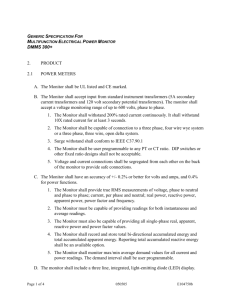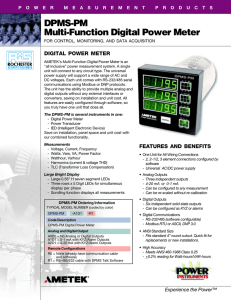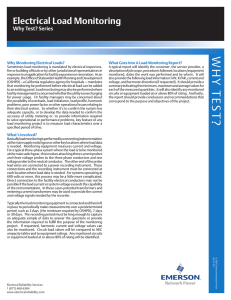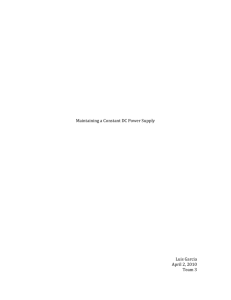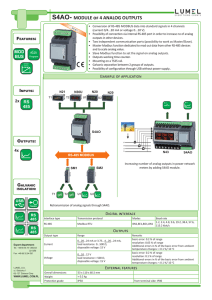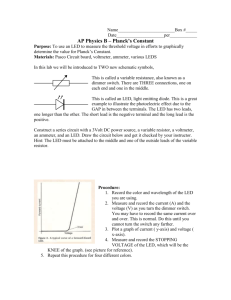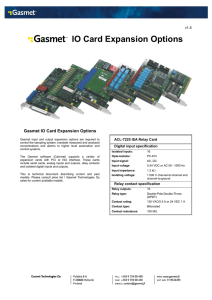generic spec for multifunction electrical power
advertisement
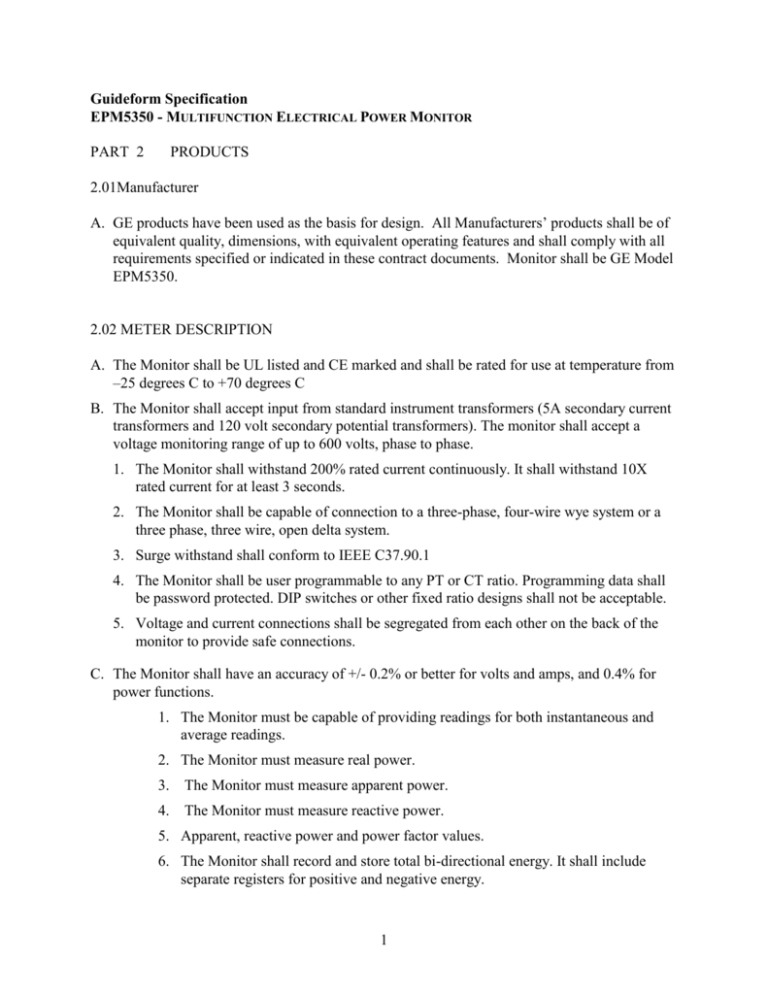
Guideform Specification EPM5350 - MULTIFUNCTION ELECTRICAL POWER MONITOR PART 2 PRODUCTS 2.01Manufacturer A. GE products have been used as the basis for design. All Manufacturers’ products shall be of equivalent quality, dimensions, with equivalent operating features and shall comply with all requirements specified or indicated in these contract documents. Monitor shall be GE Model EPM5350. 2.02 METER DESCRIPTION A. The Monitor shall be UL listed and CE marked and shall be rated for use at temperature from –25 degrees C to +70 degrees C B. The Monitor shall accept input from standard instrument transformers (5A secondary current transformers and 120 volt secondary potential transformers). The monitor shall accept a voltage monitoring range of up to 600 volts, phase to phase. 1. The Monitor shall withstand 200% rated current continuously. It shall withstand 10X rated current for at least 3 seconds. 2. The Monitor shall be capable of connection to a three-phase, four-wire wye system or a three phase, three wire, open delta system. 3. Surge withstand shall conform to IEEE C37.90.1 4. The Monitor shall be user programmable to any PT or CT ratio. Programming data shall be password protected. DIP switches or other fixed ratio designs shall not be acceptable. 5. Voltage and current connections shall be segregated from each other on the back of the monitor to provide safe connections. C. The Monitor shall have an accuracy of +/- 0.2% or better for volts and amps, and 0.4% for power functions. 1. The Monitor must be capable of providing readings for both instantaneous and average readings. 2. The Monitor must measure real power. 3. The Monitor must measure apparent power. 4. The Monitor must measure reactive power. 5. Apparent, reactive power and power factor values. 6. The Monitor shall record and store total bi-directional energy. It shall include separate registers for positive and negative energy. 1 7. The Monitor shall record and store total bi-directional accumulated energy and total accumulated apparent energy. Reporting total accumulated reactive energy shall be an available option. 8. The Monitor shall monitor max/min average demand values for all current and power readings. The demand interval shall be user programmable. D. The monitor shall include a three-line, integrated, light-emitting diode (LED) display. 1. The measured values must be displayed on LED’s that are at least 0.56” high on each of the 3 separate lines. 2. The Monitor must be capable of displaying one leg of volts, amps and total power simultaneously. 3. The display shall provide user access to all phase voltages (phase to neutral and phase to phase), currents (phase and neutral), watts, VARs, VA, power factor, frequency and kwh. 4. The display must provide user access to max/min values for all displayed quantities. E. The monitor shall include output options for analog milli-amp signals. 1. The Monitor shall have multiple channels of analog output, 0-1mA or 4-20mA, with maximum of 10 channels available. 2. The analog outputs must map to any of the instantaneous readings. 3. At least 3 of the 0-1mA analog outputs must be bi-directional. F. The monitor shall include output options for pulse outputs and relay/alarm outputs. 1. The Monitor shall have two form C, dry contact relay outputs for alarm or control and 1 KYZ pulse output related to Watt/HR, VA/HR, or VAR/HR. 2. The Monitor must be capable of tripping its dry contact outputs for the following conditions: Over/Under Voltage - Phase to Neutral and Phase to Phase Over/Under Current - Phases A, B, C and Neutral Voltage Phase Reversals Voltage Imbalance Reverse Power Over/Under KVA Over/Under PF Lag or Lead Over/Under %THD or K-Factor Over/Under Frequency 3. The Monitor must also offer both hysteresis and fail-safe modes for each of the two tripping relays. 4. The Monitor must have “and/or” logic, relay set delays, relay reset delays and positive/negative logic. 2 5. The Monitor shall also have the capability of offering 3 distinct KYZ pulses with outputs that can be mapped to any Watt/hr, VAR/hr or VA/hr reading. G. The monitor shall be microprocessor based and shall be fully user programmable. 1. The Monitor must store 3 separate copies of the critical setup data in a write protected EEPROM. All 3 copies of the critical data must have independent checksums. 2. The Monitor shall be configured through the front panel or through a computer interface. It shall not be necessary to dismantle the monitor to perform programming functions. 3. Configuration data shall be password protected. H. The monitor shall be capable of utilizing either an RS232 or RS485 digital communications port. 1. The Monitor shall have a MODBUS RTU/ MODBUS TCP/IP/ ASCII, and DNP 3.0 and protocol available as standard protocols. 2. The Monitor shall have Ethernet communications 10MB/Sec, Serial 485 and a communications baud rate of 9600 or higher. 3. The Monitor shall have the capability of having up to 9999 separate addresses for multi-point communication. 4. The digital port connections shall be separated from the voltage and current connections. I. The monitor shall be capable of gathering and reporting harmonic data. 1. The Monitor shall calculate the harmonic signature, %THD and K-Factor for all voltage and current inputs with valid data for harmonic spectrum capability to the 31st harmonic. 2. The Monitor must be capable of capturing a graphic image of the waveform for each of the 6 channels of Voltage and Current and make it available in a RAM buffer for retrieval through the digital communication port. J. The monitor case shall be fully enclosed and shielded. 1. The Monitor shall fit a standard 4 1/2” switchboard instrument size mounting per ANSI C39.1. Any other mounting configuration shall be unacceptable. 2. The Monitor shall have a separable input module which can be remote mounted up to 3 feet from the display mounting. 3. The Monitor shall be rated for use at temperature from –25oC to +70oC. K. The Monitor shall support control power options for 120 VAC, 230 VAC, 125 volts AC/DC, or 24-48 VDC. 3
